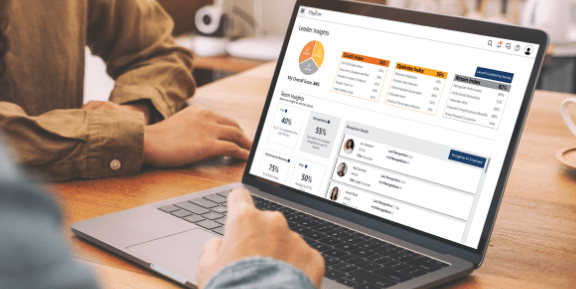How many times have you been asked to predict which employees will quit, and your best guess is basically “the unhappy ones”? Or had to justify why turnover spiked last quarter and you’ve got nothing but “gut” to back you up?
Many HR teams are making important people decisions based on nothing more than intuition, assumptions, and whatever data they can piece together from disparate systems. Meanwhile, your marketing team has detailed analytics on every website visitor, and sales can tell you exactly which leads are most likely to convert.
Your people decisions have way more impact on business success than whether someone clicks an ad. But you’re flying blind. That’s what people analytics fixes.
What is People Analytics?
People analytics is what happens when you stop guessing about your workforce and start using data and statistical methods to understand, measure, and improve how people work within an organization. It involves analyzing employee data to make better business decisions about hiring, performance, engagement, and retention.
Think of it like this:
Instead of wondering why your best employees keep leaving, you can identify the warning signs months earlier. Instead of hiring based on whether someone “seems like a good cultural fit,” you can spot the characteristics that actually predict success in your organization.
At its core, people analytics helps you answer big questions:
- Which employees are flight risks?
- What factors predict high performance in specific roles?
- How do different management styles affect team productivity?
- Which hiring sources produce the best long-term employees?
The goal isn’t to turn employees into numbers. It’s to use data to better understand the human side of your business well enough to make the best decisions you can, anchored in what’s “really real,” not assumptions and best guesses from past experiences.
Purpose of People Analytics
Traditional HR operates on intuition, best practices from other companies, and whatever worked last time. But when you’re trying to scale, predict problems, or justify budget decisions, “it feels right” doesn’t cut it.
The purpose of people analytics is to transform HR from a function that reacts to problems into one that can prevent them. When you can see that employees in certain departments show early signs of disengagement, you can intervene before they decide to leave. When you understand what characteristics predict success in specific roles, you can hire smarter.
But the real power is connecting people decisions to business outcomes. You’re not just tracking whether employees are happy—you’re understanding how their engagement affects customer satisfaction, productivity, and revenue. That’s the kind of insight that gets executive attention and budget approval.
How People Analytics is Different from HR Analytics
Most people use these terms interchangeably, but the distinction matters for how you approach your data strategy.
HR analytics focuses on making HR processes more efficient. How long does it take to fill a position? What’s our cost-per-hire? How many people completed diversity training? It’s about operational metrics that help HR do its job better.
People analytics focuses on workforce impact and less about HR efficiency. Instead of just measuring time-to-hire, you’d analyze whether candidates hired faster or slower perform better long-term. Instead of tracking training completion rates, you’d examine whether specific training programs actually improve performance.
HR analytics helps you run HR more smoothly. People analytics helps you understand how your workforce drives business results.
Types of People Analytics
People analytics isn’t one thing—it’s a spectrum of approaches that get progressively more sophisticated (and more valuable).
- Descriptive Analytics tells you what happened. Your turnover rate was 15% last quarter. Your average time-to-hire is 42 days. This is foundational stuff, but it’s backward-looking and doesn’t tell you why things happened or what to do about it.
- Diagnostic Analytics digs into the “why.” If turnover spiked in engineering, diagnostic analytics helps you figure out whether it was due to workload, management changes, compensation issues, or market conditions. This is where you start getting useful insights.
- Predictive Analytics is where things get interesting. Instead of just reacting to turnover, predictive analytics helps you identify employees who are likely to leave in the next six months. Instead of hoping your hiring process works, you can predict which candidates are most likely to succeed.
- Prescriptive Analytics is the holy grail — it tells you what actions to take. The system might recommend specific retention strategies for at-risk employees or suggest which training programs would have the biggest impact on performance. This requires sophisticated modeling, but the payoff can be huge.
- Real-time Analytics keeps you from waiting for quarterly reports to discover problems. You get alerts when important metrics change, so you can respond quickly instead of finding out about issues weeks later.
Benefits of Effective People Analytics
Understanding what’s driving turnover and engagement are just two of the benefits your business gains from effective people analytics.
Reduced Turnover
The most immediate payoff from HR people analytics is understanding why people actually leave — not just what they say in exit interviews. When you can identify the early warning signs of disengagement, you can intervene.
But it goes deeper than just tracking who’s leaving. You can understand the specific factors that drive retention in your organization. Maybe it’s not about money — maybe employees who don’t get meaningful feedback in their first 90 days are twice as likely to quit. Or maybe certain managers consistently have higher retention rates, and you can figure out what they’re doing differently.
The key is moving from reactive (conducting exit interviews after people leave) to proactive (identifying and addressing issues while you can still save good employees).
Informed Hiring Decisions
Most hiring processes are expensive experiments. You think someone will be great, but you won’t know for months whether you were right. But using people analytics in HR changes that by identifying the characteristics, experiences, and sources that predict long-term success in your organization.
This isn’t about reducing hiring to a formula—cultural fit and soft skills still matter. But when you can see that candidates from certain backgrounds consistently outperform others, or that employees hired through specific channels stay longer, you can make smarter decisions.
What’s particularly valuable is understanding your own patterns. Industry best practices might not apply to your specific situation, but your data will show you what actually works in your environment.
Increased Engagement
Employee engagement surveys are nice, but they don’t tell you what to do with the results. People analytics helps you understand what drives engagement in your specific workforce—which can be very different from generic best practices.
Maybe flexible work arrangements are your secret weapon. Maybe it’s career development opportunities. Maybe it’s recognition programs. The power is in the specificity—you can focus on what actually matters to your people instead of implementing generic initiatives.
What’s even better is when you can connect engagement to business outcomes. When you can show that engaged teams have higher customer satisfaction scores, you’ve got a business case for your engagement investments.
Increased Productivity
When you understand what makes teams and individuals productive, you can replicate those conditions across your organization. This might reveal insights about optimal team sizes, the impact of different work arrangements, or the relationship between specific skills and performance.
You might discover that teams with certain personality type combinations perform better on creative projects, or that employees who receive regular coaching show higher productivity. These insights let you make strategic decisions about team composition and development investments.
The goal isn’t to micromanage—it’s to create environments where people can do their best work.
Effective Workforce Management
Traditional workforce planning is mostly guesswork based on historical trends. People analytics enables more sophisticated planning by analyzing patterns in growth, turnover, and skill development to predict future needs.
This is especially critical in fast-changing industries where skill requirements evolve quickly. Instead of discovering skill gaps after they hurt your business, you can anticipate future needs and start developing or recruiting talent proactively.
People Analytics Data Metrics
The people data metrics you track should solve specific problems, not just fill dashboards. Focus on data that helps you make better decisions.
- Workforce Data: Basic headcount by department and role, plus demographic breakdowns. But don’t stop there—track span of control and organizational structure changes. These provide context for everything else.
- Hiring Metrics: Time-to-hire and cost-per-hire are fine, but they don’t tell you if you’re hiring well. Track quality-of-hire indicators (performance ratings, retention rates by hiring source), candidate experience scores, and which recruitment channels produce your best long-term employees.
- Performance: Goal achievement rates and 360-degree feedback scores, but connect them to business outcomes. Track productivity measures that are specific to different roles, not generic “productivity” metrics that don’t mean anything.
- Engagement Metrics: Pulse survey results and eNPS scores are starting points. The real value comes from correlating these with other metrics to understand what drives engagement in your organization. Survey data without context is just noise.
- Turnover: Overall turnover rates don’t tell you much. Break it down by performance level, tenure, and role. High performer turnover tells a completely different story than overall turnover. Track voluntary versus involuntary turnover, and dig into the timing patterns.
- Learning Data: Training completion rates are easy to track but don’t prove anything. Focus on the correlation between development activities and performance outcomes. Which training programs actually make people better at their jobs?
- Compensation Metrics: Pay equity analysis, benefit utilization rates, and the relationship between compensation and performance or retention. But remember—compensation data is only useful if it helps you make better decisions about how to invest in your people.
How to Implement People Analytics in HR
Now that you know the benefits and understand the various metrics, it’s time to get to work putting it into practice.
Start with the Problems You’re Trying to Solve
Most organizations make the mistake of starting with the data they have instead of the questions they need to answer. Don’t do that.
Begin by identifying your biggest HR and people analytics challenges. Are you losing too many high performers? Having trouble identifying future leaders? Seeing productivity gaps between teams?
Your objectives should be specific, measurable, and tied to business outcomes. “Better people analytics” isn’t a goal—it’s a tool. “Reduce high-performer turnover by 25%” is a goal.
Figure Out What Data You Actually Have
Most organizations have more people data than they realize, but it’s scattered across different systems and is often inconsistent. Conduct an audit of what you currently collect, where it’s stored, and how reliable it is.
This includes obvious sources like your HRIS and payroll systems, but also less obvious sources like calendar data, badge swipe information, and even email metadata. Don’t try to collect everything—focus on data that’s relevant to your specific objectives.
Invest in Tools That Actually Work Together
You don’t need enterprise-level analytics software to get started, but you do need tools that can handle people data effectively. This might mean upgrading your HRIS, implementing a dedicated people analytics platform, or starting with more advanced spreadsheet capabilities.
The key is choosing tools that integrate with your existing systems and can grow with your needs. Avoid creating new data silos that make analysis harder.
Build or Buy Analytics Capabilities
People data analytics requires different skills than traditional HR work. You need people who can work with data, understand statistical analysis, and translate insights into actionable recommendations.
This might mean hiring dedicated people analytics professionals, training existing HR staff, or partnering with data scientists from other departments. The important thing is having someone who can bridge the gap between data and decision-making.
Start Small and Prove Value
Don’t try to implement a comprehensive people analytics program overnight. Start with one or two specific use cases where you can demonstrate value quickly. Success with smaller projects builds support and momentum for larger initiatives.
Choose projects where you have decent data available and where the potential impact is clear. Employee retention analysis or hiring source effectiveness are often good starting points because the business case is obvious.
Establish Clear Governance and Privacy Protocols
People data is sensitive, and employees need to trust that their information is being used appropriately. Establish clear policies about what data you collect, how it’s used, and who has access to it.
This includes compliance with privacy regulations, but also goes beyond legal requirements to consider employee comfort and trust. Transparency about your people analytics efforts is usually better than secrecy.
People Analytics Challenges
No system is perfect, and there are some challenges your business should understand before implementing people analytics.
Data Quality
Data quality and integration issues are the biggest headache most organizations face. People data comes from multiple sources with different formats, definitions, and quality levels. Employee records might be inconsistent, performance data could be subjective, and survey response rates might be terrible.
Ethical Concerns
Privacy and ethical concerns are increasingly important as analytics becomes more sophisticated. Employees may be uncomfortable with certain types of data collection, and there are legitimate questions about how insights should be used. The line between helpful analytics and employee surveillance can be uncomfortably thin.
Resistance
Resistance to change can come from multiple directions. Some managers may be skeptical of data-driven approaches, especially if they conflict with their experience. Employees might worry about being “reduced to numbers” or that analytics will be used against them.
Technology
Technology limitations can constrain what’s possible, especially in organizations with legacy systems or limited IT resources. Without the right tools, even simple analyses can be time-consuming and error-prone.
Metrics
Overemphasis on metrics is a real risk when organizations become so focused on measurement that they lose sight of the human element. Not everything important can be quantified, and factors like culture and values might get overlooked.
Best Practices for Using People Analytics
As an HR leader, you want to start on the right foot. Here’s are some best practices about using HR analytics.
Connect Everything to Business Outcomes
The most successful HR people analytics initiatives are those that directly impact business results. Instead of just tracking HR metrics, focus on questions that matter to organizational success. How does employee engagement affect customer satisfaction? Which management practices drive the highest team performance?
This business focus helps secure buy-in from leadership and ensures your analytics contribute to strategic objectives, not just operational efficiency.
Don’t Skip the Data Quality Work
Your insights are only as good as your data. Invest time in cleaning and standardizing your data before analysis. This includes establishing consistent definitions, addressing missing information, and validating accuracy.
Don’t let perfect be the enemy of good, but make sure your data is reliable enough to support the decisions you’re making. Document your data sources and limitations so stakeholders understand the context.
Mix Numbers with Stories
Numbers tell part of the story, but they don’t explain why things happen. Combine quantitative analysis with qualitative insights from surveys, interviews, and focus groups. This mixed approach provides a more complete understanding of workforce dynamics.
If your data shows higher turnover in certain departments, qualitative research can help you understand whether it’s due to workload, management style, career opportunities, or other factors.
Make Insights Actionable
The best analytics in the world won’t drive change if insights aren’t communicated effectively. Focus on storytelling rather than just presenting data. Help stakeholders understand what the numbers mean and what actions they should take.
Use visualizations to make complex data accessible, but don’t overwhelm audiences with too much information. Clarity and actionability matter more than comprehensiveness.
Build and Maintain Trust
Be transparent about your people analytics efforts and how employee data is used. Establish clear policies about data collection, analysis, and decision-making. Consider involving employee representatives in developing these policies.
Trust is essential for success. If employees believe their data might be used against them, they’re less likely to provide honest feedback and more likely to resist analytics initiatives.
Act on What You Learn
Analytics without action is just expensive reporting. Make sure insights lead to concrete changes in policies, processes, or practices. Track the impact of these changes to demonstrate the value of your analytics efforts.
This might mean implementing new retention strategies, changing hiring practices, or adjusting management development programs. The key is closing the loop between insight and action.
How Paycor Helps with People Analytics
Paycor’s comprehensive HCM software solves one of the biggest challenges in people analytics: data integration. Instead of trying to combine information from separate systems for payroll, benefits, time tracking, and performance management, everything flows through a single platform with consistency.
This integration makes your people analysis more reliable and your insights more actionable. When your data comes from one source with consistent definitions, you spend less time cleaning data and more time finding insights.
But Paycor goes beyond just consolidating data. The platform provides analytics capabilities that help you move from insight to action. You can track key people metrics, identify trends, and get recommendations for specific interventions.
The platform is designed for HR professionals, not data scientists. You get pre-built dashboards for common use cases, but it’s flexible enough to support custom analysis when you need to dig deeper into specific questions.
Use Paycor for Your HR People Analytics
Take a guided tour today to see how Paycor can transform your approach to people analytics and help you unlock the full potential of your workforce.
People Analytics FAQs
Still want to know more about people analytics? Read on.
What are the 7 pillars of people analytics?
The seven pillars of people analytics include data infrastructure, analytical capabilities, business alignment, privacy and ethics, storytelling, action orientation, and continuous improvement. These work together to create comprehensive people analytics capability. You can’t skip any without compromising effectiveness, but you don’t need to perfect all of them before getting started.
How does people analytics improve employee retention and engagement?
People analytics identifies the specific factors that drive retention and engagement in your organization. Instead of generic programs, you can focus on interventions that actually work for your workforce. For retention, it identifies early warning signs so you can intervene before employees leave. For engagement, it reveals which practices have the biggest impact on satisfaction and commitment.
How will AI impact people analytics?
Yes. In fact, AI is already transforming people analytics by automating routine analysis, identifying patterns humans might miss, and providing sophisticated predictive capabilities. However, AI also raises questions about bias, transparency, and privacy. The future likely involves AI handling analytical work while humans focus on interpretation and decision-making.
Can Paycor software be used for people analytics?
Yes, Paycor’s HCM platform is designed to support people analytics initiatives. Our integrated system captures comprehensive workforce data, and our HR analytics software provide the tools needed to analyze this data effectively. The platform includes pre-built reports for common use cases but is flexible enough to support custom analysis.









